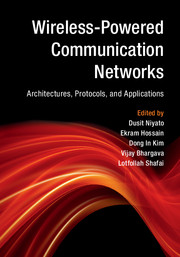Book contents
- Frontmatter
- Contents
- List of contributors
- Preface
- Part I Basics of Wireless Energy Harvesting and Transfer Technology
- Part II Architectures, Protocols, and Performance Analysis
- 4 Cooperative Networks with Wireless Energy Harvesting
- 5 Multiple Antennas and Beamforming for SWIPT Systems
- 6 Backscattering Wireless-Powered Communications
- 7 Dedicated Wireless Energy Harvesting in Cellular Networks: Performance Modeling and Analysis
- 8 Ambient Wireless Energy Harvesting in Small Cell Networks: Performance Modeling and Analysis
- Part III Applications of Wireless Energy Harvesting and Transfer
- Index
- References
7 - Dedicated Wireless Energy Harvesting in Cellular Networks: Performance Modeling and Analysis
from Part II - Architectures, Protocols, and Performance Analysis
Published online by Cambridge University Press: 01 December 2016
- Frontmatter
- Contents
- List of contributors
- Preface
- Part I Basics of Wireless Energy Harvesting and Transfer Technology
- Part II Architectures, Protocols, and Performance Analysis
- 4 Cooperative Networks with Wireless Energy Harvesting
- 5 Multiple Antennas and Beamforming for SWIPT Systems
- 6 Backscattering Wireless-Powered Communications
- 7 Dedicated Wireless Energy Harvesting in Cellular Networks: Performance Modeling and Analysis
- 8 Ambient Wireless Energy Harvesting in Small Cell Networks: Performance Modeling and Analysis
- Part III Applications of Wireless Energy Harvesting and Transfer
- Index
- References
Summary
Introduction
Energy harvesting in wireless cellular networks is a cornerstone of emerging 5G and beyond 5G (B5G) cellular networks as it aims to “cut the last wires” of the existing wireless devices [1]. In particular, energy harvesting has a significant potential to attract subscribers since it promotes mobility and connectivity anywhere and anytime, which is one of the key visions of next-generation wireless networks. In general, wireless energy harvesting can be classified according to the following two categories.
• Ambient energy harvesting (EH). This refers to energy harvested from renewable energy sources (such as thermal, solar, wind, etc.) as well as energy harvested from radio signals of different frequencies in the environment that can be sensed by EH receivers (e.g., co-channel interference, TV or radio broadcasting, etc.).
• Dedicated EH. This enables the intentional transmission of energy from dedicated energy sources to energy harvesting devices.
To satisfy the power demands of delay-constrained wireless applications, it is of utmost importance to ensure the availability of sufficient energy at the user terminals whenever required. This fact has motivated researchers toward the development of dedicated wireless-powered cellular networks (WPCNs) where dedicated energy sources or hybrid access points (HAPs) take care of both energy transfer and information transmission to and from the subscribers.
In this chapter, we focus on dedicated EH techniques. We first highlight the associated challenges. Next, we theoretically characterize and comparatively analyze a number of different network architectures for centralized and distributed dedicated wireless EH. Numerical results are provided to validate the analytical results.
Major Challenges in Dedicated Wireless Energy Harvesting
In this section, we will discuss a number of major challenges related to dedicated wireless energy harvesting (WEH) from the perspective of network architecture and modeling and resource allocation.
Network Architectures for Wireless Energy Harvesting
Different network architectures have been studied for WEH. However, most of the studies have been limited to a two- or three-node network model, a central base station (BS) that takes care of both the wireless information transmission and energy transfer, and follows a specific configuration of energy harvesting; i.e., a user harvests energy from a centralized half-duplex BS or full-duplex BS or through randomly deployed power beacons (PBs), etc.
- Type
- Chapter
- Information
- Wireless-Powered Communication NetworksArchitectures, Protocols, and Applications, pp. 246 - 264Publisher: Cambridge University PressPrint publication year: 2016



